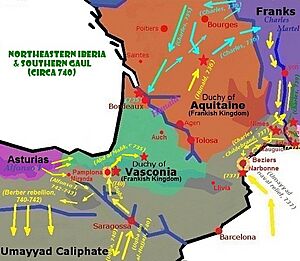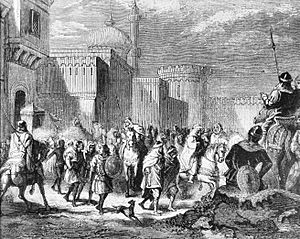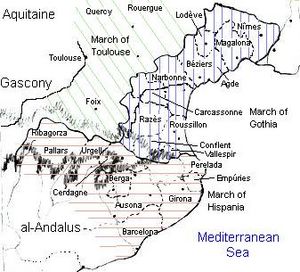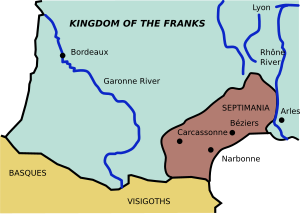Septimania facts for kids
Septimania (pronounced sep-tee-MAH-nee) was an important historical region in what is now Southern France. It was once the western part of a big Roman area called Gallia Narbonensis. In 462 AD, this land was given to the Visigoths, a powerful group led by their king, Theodoric II.
For a long time in the Early Middle Ages, people called this area by different names like Gallia Narbonensis or just Gallia. Today, the area of Septimania is mostly covered by the French region of Occitanie. When the Visigoths ruled, Septimania was a key part of their kingdom, which had its main city in Toledo. The main religious leader for the area was the Archbishop of Narbonne.
In 719 AD, Muslim armies from Al-Andalus (modern-day Spain) invaded Septimania. They renamed it Arbūnah and used it as a base for more military actions. The region was briefly part of the Emirate of Córdoba. But then, in 759 AD, the Christian Franks took it over after a long fight. By the end of the 800s, the Franks called it Gothia or the Gothic March.
After the Franks won, the Muslim Arabs and Berbers left after about 40 years. The Frankish king, Pepin the Short, became even stronger. Septimania became a border area (called a march) of the Carolingian Empire. Even though it was part of the Frankish kingdom, it kept its own culture and way of life. The region was also influenced by nearby areas like Toulouse and Provence. It was part of a larger area in Southern France known as Occitania, which had its own language and culture. French kings finally took full control of this area in the early 1200s after the Albigensian Crusade. From the late 1200s, Septimania became the royal province of Languedoc.
The name "Septimania" might come from the Roman name of the city of Béziers, Colonia Julia Septimanorum Baeterrae. This name refers to Roman soldiers from the Seventh Legion who settled there. Another idea is that the name comes from the seven main cities in the area: Béziers, Elne, Agde, Narbonne, Lodève, Maguelonne, and Nîmes. Septimania stretched from the Mediterranean Sea almost to the Garonne river in the northwest. The Rhône river was its eastern border, separating it from Provence. To the south, the Pyrénées mountains formed its boundary.
Contents
Visigothic Control of Narbonensis
How the Goths Gained Land
In the 450s, the Visigoths settled in Aquitaine as allies of the Western Roman Empire. By 462 AD, the Roman Empire, led by Ricimer, officially gave the Visigoths the western half of the province of Gallia Narbonensis. The Visigoths also took over Provence (eastern Narbonensis). It wasn't until 475 AD that the Visigothic king, Euric, gave Provence back to the Empire. In return, the Roman emperor Julius Nepos recognized the Visigoths as fully independent.
Visigothic Kingdom of Narbonne
The Visigoths were Arian Christians, which meant they had different beliefs from the Catholic Franks in Gaul. This difference caused problems. In 507 AD, Clovis I, the Frankish king, invaded the Visigothic kingdom, whose capital was in Toulouse. Clovis defeated the Goths in the Battle of Vouillé. The young Visigothic king, Amalaric, was taken to safety in Spain. Gesalec was chosen to be the new king and ruled from Narbonne.
Clovis and his allies conquered most of Visigothic Gaul, including Toulouse. They tried to take Carcassonne, a strong city protecting the Septimanian coast, but the Ostrogoths stopped them in 508 AD. So, Septimania remained in Visigothic hands.
The Ostrogothic king Theodoric the Great later took Narbonne back from the Burgundians and made it the capital of the province. When Theodoric died in 526 AD, Amalaric became king and made Narbonne his capital. However, the Frankish king Childebert I invaded Septimania in 531 AD. He chased Amalaric to Barcelona. The Franks didn't keep the province. After Amalaric, the Visigothic kingdom's main power shifted to Spain, and Theudis made Barcelona his capital.
Gothic Province of Gaul
By the time Leovigild ruled, the Visigothic Kingdom was centered in Toledo. The province of Gallia Narbonensis (often called just Gallia or Narbonensis) was a special part of the kingdom. It was the only province outside of Spain, north of the Pyrénées mountains, and it bordered the powerful Franks.
Kings after Alaric II liked Narbonne as a capital. But they were twice defeated by the Franks and forced back to Barcelona. Septimania was a dangerous border area. In 568 AD, when Liuva I became king, he gave Spain to his son Leovigild and kept Septimania for himself.
During a revolt by Hermenegild against his father Leovigild (583–585 AD), Septimania was invaded by Guntram, the King of Burgundy. This attack was likely to support Hermenegild. The Frankish attack in 585 AD was pushed back by Hermenegild's brother Reccared. The Franks wanted Septimania throughout the 500s, but they could never take it. The last attempt was in 589 AD, and they were defeated near Carcassonne.
In the 600s, Gallia often had its own governors, usually Visigoths. Most public jobs were also held by Goths, even though they were a smaller part of the population.
Culture in Gothic Septimania
The local people in Gallia were called "Gauls" by Visigothic writers. There was often a strong dislike between the Goths and the Gauls. We know a lot about some old Gothic beliefs in Septimania from church records. For example, some people still didn't work on Thursdays to honor the Roman god Jupiter. The church council in Narbonne in 590 AD tried to stop this. They also punished fortunetellers by whipping them and selling them into slavery.
There are different ideas about how much the Visigoths and Franks interacted. Some believe there was very little cultural exchange. For example, coins from the Visigothic Kingdom of Hispania did not circulate in Gaul outside Septimania. Also, Frankish coins were not used in the Visigothic Kingdom. This suggests that there wasn't much trade or movement of people across the border.
Muslim and Frankish Septimania

In 719 AD, Arab and Berber Muslim forces from al-Andalus (Spain), led by al-Samh ibn Malik al-Khawlani, invaded Septimania. They took over the local Visigothic kingdom in 720 AD. The region was renamed Arbūnah and became a military base. After taking Narbonne, which had an important port, al-Samh conquered other Septimanian cities like Béziers, Agde, and Nîmes.
By 721 AD, al-Samh was ready to attack Toulouse. But his plans were ruined at the Battle of Toulouse in 721 AD. The Aquitanian Christian army, led by Odo the Great, defeated the Muslim army. Al-Samh was badly wounded and died soon after. Even so, Muslim forces based in Narbonne continued to attack. They conquered Carcassonne in 725 AD and reached as far east as Autun.
In 731 AD, a Berber leader named Uthman ibn Naissa (called Munuza by the Franks) allied with Duke Odo. But this rebel leader was killed by the Arab commander Abd al-Rahman ibn Abd Allah al-Ghafiqi.
The Frankish king Charles Martel then turned his attention to Septimania and Provence. In 737 AD, the Frankish king attacked Narbonne. However, the local Gothic and Gallo-Roman nobles had made agreements to resist the growing Frankish power. Charles Martel tried to conquer all of Septimania and besieged Narbonne in 737, but his forces could not take the city. When Arabs sent more soldiers from Spain, the Frankish army stopped them at the River Berre and won a big victory. After that, the Frankish army marched on Nîmes.
Around 747 AD, the Septimania region was given to Umar ibn Umar to govern. But Muslim rule began to weaken by 750 AD. In 752 AD, the Carolingian king Pepin the Short marched south to Septimania. The Gothic leaders of Nîmes, Melguelh, Agde, and Béziers refused to obey the emir in Córdoba. Instead, they declared their loyalty to the Frankish king. These Gothic leaders and the Franks then began to besiege Narbonne.
By 759 AD, Narbonne was not getting help from Spain because of internal conflicts there. Finally, the Gothic defenders of Narbonne surrendered to the Franks. They killed the Arab-Berber Muslim soldiers inside and opened the city gates to Pepin's army. Pepin had promised to respect the Gothic laws and their local government. This helped him gain the loyalty of the Gothic nobles in Septimania.

Narbonne finally fell in 759 AD. Pepin kept his promise to uphold the Visigothic law. The county was given to Miló, who had been the Gothic leader during Muslim times. This helped Pepin gain the loyalty of the Septimanian Goths against Duke Waifer, the independent ruler of Aquitaine. After the Franks took Narbonne, the Muslim Arabs and Berbers were defeated and left for Spain after 40 years. King Pepin the Short became even more powerful. After Narbonne, Pepin took Roussillon and then focused his efforts on Aquitaine.
Gothia in Carolingian Times

The region of Roussillon was taken by the Franks in 760 AD. Pepin then moved northwest to Aquitaine, starting a war against Waifer of Aquitaine. Albi, Rouergue, Gévaudan, and the city of Toulouse were conquered. In 777 AD, some Muslim leaders from Spain offered to submit to Charlemagne, the Frankish king. However, when Charlemagne invaded in 778 AD, one leader refused, and Charlemagne had to retreat. In the Pyrénées, the Basques defeated his forces at Roncesvalles.
Charlemagne found Septimania and its borderlands very empty and damaged by war. Many people were hiding in the mountains. So, he gave land to Visigothic and other refugees. Charlemagne also started several monasteries in Septimania, where people gathered for safety. South of Septimania, Charlemagne created the Hispanic Marches, which were border areas of his empire. The territory was given to Louis, king in Aquitaine, but it was ruled by Frankish leaders called margraves and later dukes of Septimania.
A Frankish noble named Bernat of Septimania ruled these lands from 826 to 832 AD. His time as ruler (he was executed in 844 AD) shows how wild the 800s were in Septimania. When he was made Count of Barcelona in 826 AD, it caused a revolt among the local Catalan lords. For stopping this revolt, Louis the Pious gave Bernat many counties, which show the size of Septimania in the 800s: Narbonne, Béziers, Agde, Magalona, Nîmes, and Uzés.
After Charlemagne's rule, Septimania became known as Gothia. It kept both names while it was ruled by the counts of Toulouse in the early Middle Ages. But other names like Roussillon and Foix became more common. The names Gothia and Septimania slowly disappeared during the 900s. The region broke into smaller areas, and its culture changed into what became the culture of Languedoc. This breaking up into smaller areas and the fading of the name Gothia are likely how the old area known as Gathalania or Cathalania (today's Catalonia) got its name.
The name "Gothia" was used because more Goths lived in this area than in surrounding regions. The rulers of this area, when it included several counties, were called the Marquesses of Gothia (and also the Dukes of Septimania).
See also
 In Spanish: Septimania para niños
In Spanish: Septimania para niños
- Septimania timeline



